The NVIDIA GeForce GTX 980 Ti Review
by Ryan Smith on May 31, 2015 6:00 PM ESTPower, Temperature, & Noise
As always, last but not least is our look at power, temperature, and noise. Next to price and performance of course, these are some of the most important aspects of a GPU, due in large part to the impact of noise. All things considered, a loud card is undesirable unless there’s a sufficiently good reason – or sufficiently good performance – to ignore the noise.
As the GM200 flagship card, GTX Titan X gets the pick of the litter as far as GM200 GPUs go. GTX Titan X needed fully-functional GM200 GPUs, and even then needed GPUs that were good enough to meet NVIDIA’s power requirements. GTX 980 Ti on the other hand, as a cut-down/salvage card, gets second pick. So we expect to see these chips be just a bit worse; to have either functional units that came out of the fab damaged, or have functional units that have been turned off due to power reasons.
| GeForce GTX Titan X/980 Voltages | ||||
| GTX Titan X Boost Voltage | GTX 980 Ti Boost Voltage | GTX 980 Boost Voltage | ||
| 1.162v | 1.187v | 1.225v | ||
Looking at voltages, we can see just that in our samples. GTX 980 Ti has a slightly higher boost voltage – 1.187v – than our GTX Titan X. NVIDIA sometimes bins their second-tier cards for lower voltage, but this isn’t something we’re seeing here. Nor is there necessarily a need to bin in such a manner since the 250W TDP is unchanged from GTX Titan X.
| GeForce GTX 980 Ti Average Clockspeeds | |||
| Game | GTX 980 Ti | GTX Titan X | |
| Max Boost Clock | 1202MHz | 1215MHz | |
| Battlefield 4 |
1139MHz
|
1088MHz
|
|
| Crysis 3 |
1177MHz
|
1113MHz
|
|
| Mordor |
1151MHz
|
1126MHz
|
|
| Civilization: BE |
1101MHz
|
1088MHz
|
|
| Dragon Age |
1189MHz
|
1189MHz
|
|
| Talos Principle |
1177MHz
|
1126MHz
|
|
| Far Cry 4 |
1139MHz
|
1101MHz
|
|
| Total War: Attila |
1139MHz
|
1088MHz
|
|
| GRID Autosport |
1164MHz
|
1151MHz
|
|
| Grand Theft Auto V |
1189MHz
|
1189MHz
|
|
The far more interesting story here is GTX 980 Ti’s clockspeeds. As we have pointed out time and time again, GTX 980 Ti’s gaming performance trails GTX Titan X by just a few percent, this despite the fact that GTX 980 Ti is down by 2 SMMs and is clocked identically. On paper there is a 9% performance difference that in the real world we’re not seeing. So what’s going on?
The answer to that is that what GTX 980 Ti lacks in SMMs it’s making up in clockspeeds. The card’s average clockspeeds are frequently two or more bins ahead of GTX Titan X, topping out at a 64MHz advantage under Crysis 3. All of this comes despite the fact that GTX 980 Ti has a lower maximum boost clock than GTX Titan X, topping out one bin lower at 1202MHz to GTX Titan X’s 1215MHz.
Ultimately the higher clockspeeds are a result of the increased power and thermal headroom the GTX 980 Ti picks up from halving the number of VRAM chips along with disabling two SMMs. With those components no longer consuming power or generating heat, and yet the TDP staying at 250W, GTX 980 Ti can spend its power savings to boost just a bit higher. This in turn compresses the performance gap between the two cards (despite what the specs say), which coupled with the fact that performance doesn't scale lineraly with SMM count or clockspeed (you rarely lose the full theoretical performance amount when shedding frequency or functional units) leads to the GTX 980 Ti trailing the GTX Titan X by an average of just 3%.
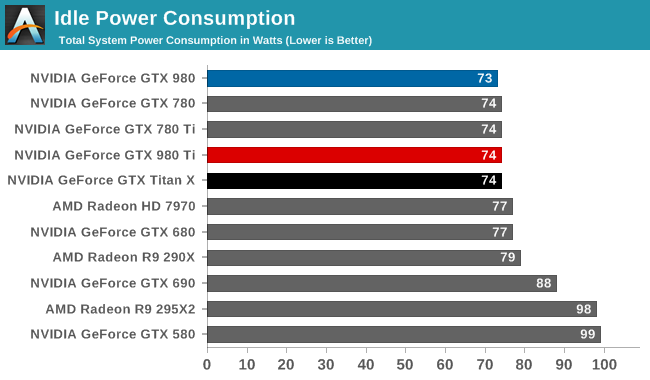
Starting off with idle power consumption, there's nothing new to report here. GTX 980 Ti performs just like the GTX Titan X, which at 74W is second only to the GTX 980 by a single watt.
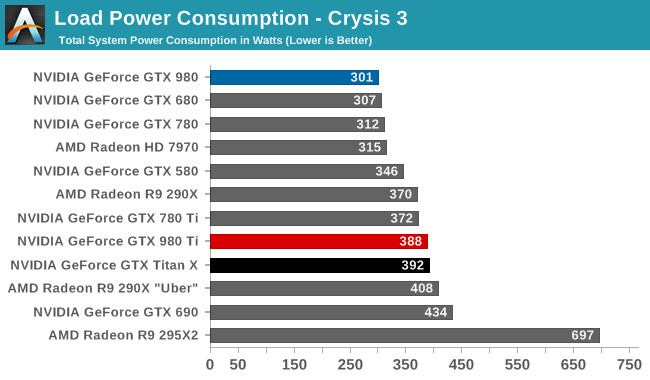
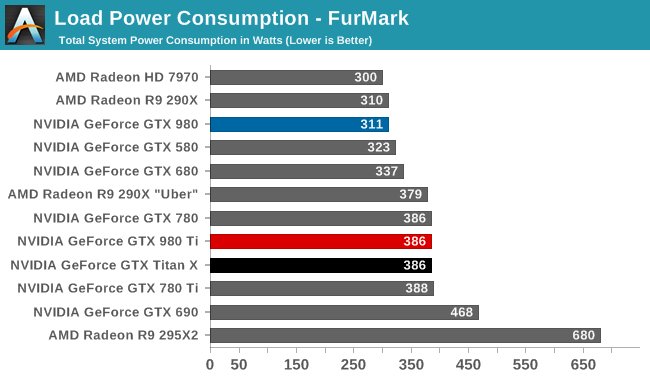
Meanwhile load power consumption is also practically identical to the GTX Titan X. With the same GPU on the same board operating at the same TDP, GTX 980 Ti ends up right where we expect it, next to GTX Titan X. GTX Titan X did very well as far as energy efficiency is concerned – setting a new bar for 250W cards – and GTX 980 Ti in turn does just as well.
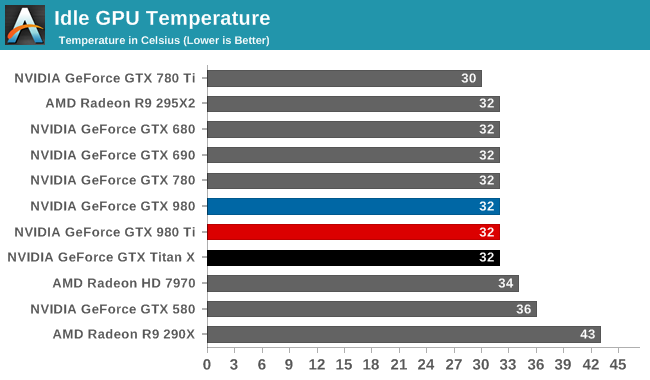
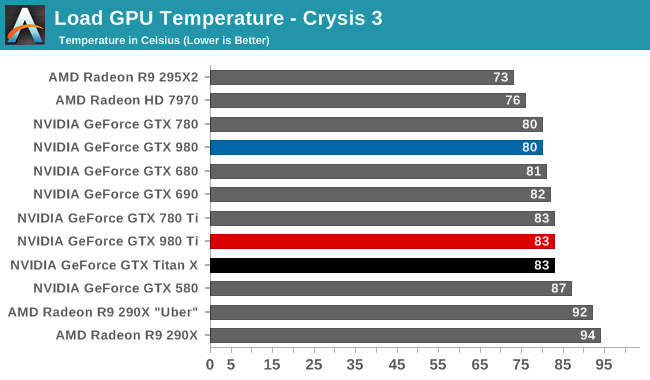
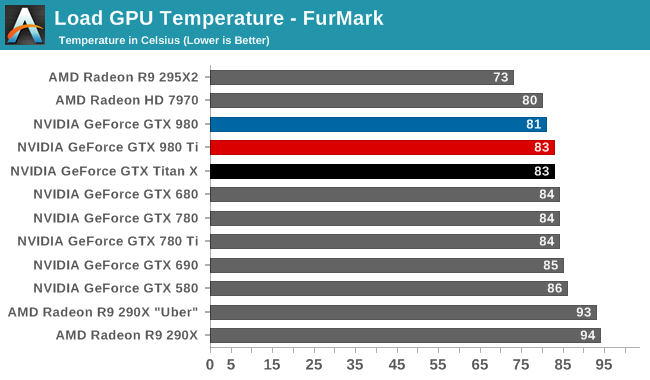
As was the case with power consumption, video card temperatures are similarly unchanged. NVIDIA’s metal cooler does a great job here, keeping temperatures low at idle while NVIDIA’s GPU Boost mechanism keeps temperatures from exceeding 83C under full load.
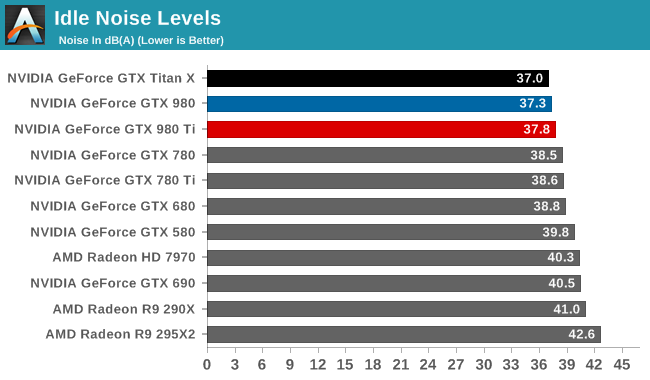
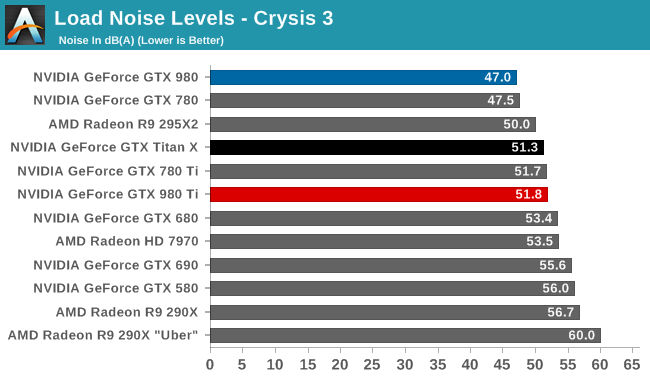
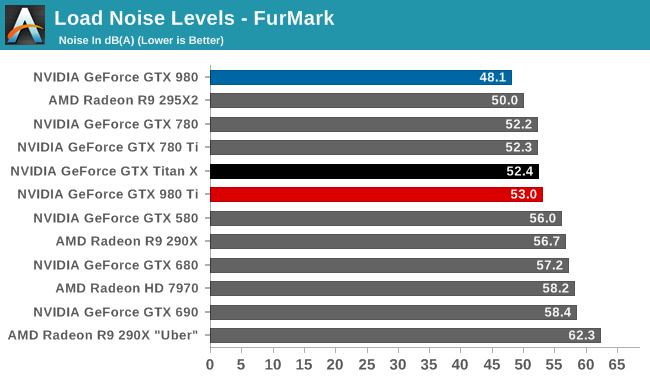
Finally for noise, the situation is much the same. Unexpected but not all that surprising, the GTX 980 Ti ends up doing a hair worse than the GTX Titan X here. NVIDIA has not changed the fan curves or TDP, so this ultimately comes down to manufacturing variability in NVIDIA’s metal cooler, with our GTX 980 Ti faring ever so slightly worse than the Titan. Which is to say that it's still right at the sweet spot for noise versus power consumption, dissipating 250W at no more than 53dB, and once again proving the mettle of NVIDIA's metal cooler.










290 Comments
View All Comments
Daroller - Monday, June 1, 2015 - link
HAHAHAHAHA website lagged out and triple posted. That's awesome. Go go Google Chrome!naxeem - Monday, June 1, 2015 - link
I don't think it is all good with the overclocking part. On stock air (albeit 80% fan speed unless used Accelero IV at 40%) cooler TitanX cards easily get to 1300/1440 normal/boost clocks. Same cards on water got to 1375/1500 with cool-ish 55°C at max load. That applies to two TitanX in SLI with modified BIOS that allows for more power consumption and thus removes artificial limit.Since the chip is identical and 980Ti is actually partially defective TitanX with 50% less RAM and switched off defective parts, I highly doubt clock potential differs, especially not in favor of 980Ti.
I would and do expect 980Ti to clock the same as Titan X (loosing some on chip quality, gaining some on half the VRAM).
FlushedBubblyJock - Saturday, June 13, 2015 - link
Nope. Other test sites show the opposite - 980TI is an overclock monster and beats the TXtruongpham - Monday, June 1, 2015 - link
Ryan, can you bench this one with Windows 10 and DX12?Ryan Smith - Monday, June 1, 2015 - link
We won't be doing any complete Win10 benchmarking until that OS is finished and released. As for DX12, there are no games out yet that re using it; the handful of benchmarks are focused tech demos.cknobman - Monday, June 1, 2015 - link
Nvidia must have seen some undisclosed AMD benchmarks, went into panic mode, and rushed a release for the 980TI to get customers before the AMD launch.While its a great card the problem is Nvidia screwed some of their own customers.
I take this as a sign that whatever AMD is coming out with must be pretty good. :)
galta - Monday, June 1, 2015 - link
Maybe, but it could prove to be of little importance.You see, Win10 will be out on June 29th. Realistically speaking, DX12 games won't be real before Christmas or 2016.
It is more than enough time for a possible counterstrike from nVidia.
Having said that, unless one really really needs to upgrade now I would strongly recommend waiting for another month, just to check what Fiji is up to.
As of me, I have a pair of 980GTX Strix and have been with nVidia for a while, but I really hope AMD gets this one right.
Real competition is always good.
JayFiveAlive - Monday, June 1, 2015 - link
I've been waiting for this beast to drop... now to decide whether it's a good time to bite.Current setup is a 2500K OC to 4.4Ghz and a GTX 670, so kinda oldish... Was considering upgrading to a Skylake proc come Sept and this 980 Ti, but probably Gigabyte variant... hmmm.
Peichen - Tuesday, June 2, 2015 - link
Why upgrade CPU? 2500K at 4.4GHz is still very fast and shouldn't affect performance of a 980Ti much. Maybe 10% less fps vs if you have a 6-core Extreme but why spend $300-400 to get 10% improvement?mapesdhs - Wednesday, June 3, 2015 - link
Plus if he does need some more CPU oomph, just put in a 2700K. I've built six so far, every one of them happily runs at 5GHz with just a decent air cooler & one fan for quiet operation, though for final setups I use an H80 and two quiet fans. Some games will benefit from more than 4 cores, depends on the game (eg. PvP online FPS can involve a lot of host side scripting, eg. Project Reality, and the upcoming Squad).True though, 2500K is still very potent, just built a 4.8 setup for a friend. She lives on an island, it'll probably be the quickest system for miles around. :D